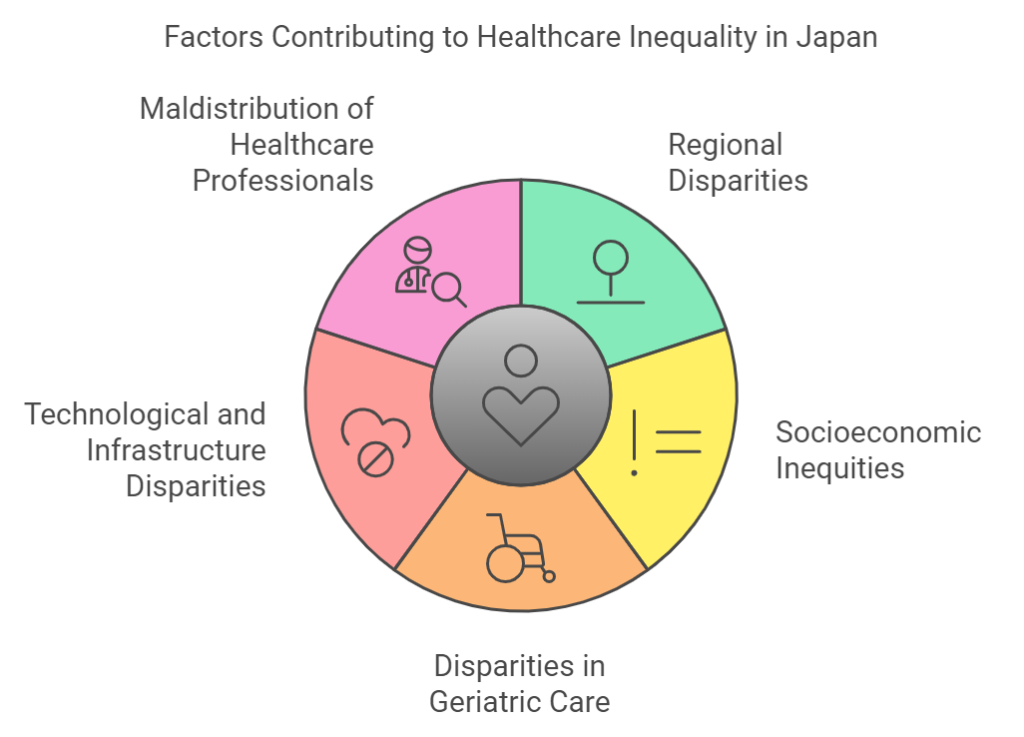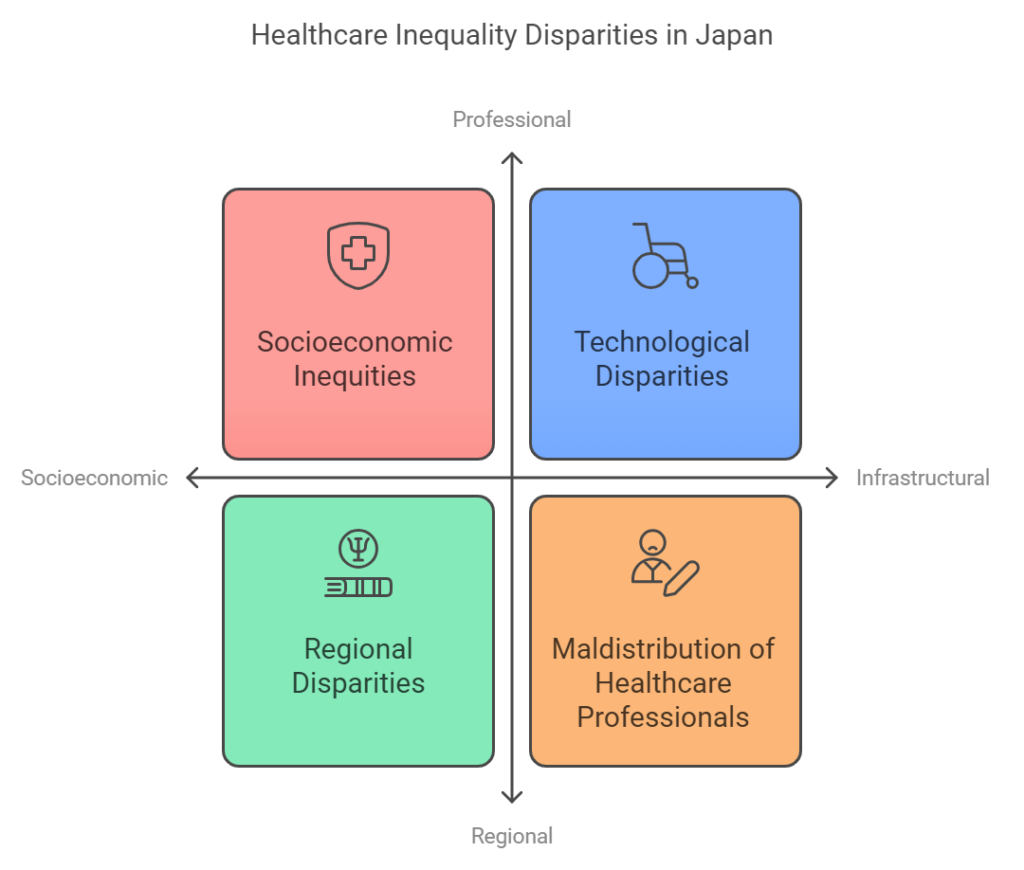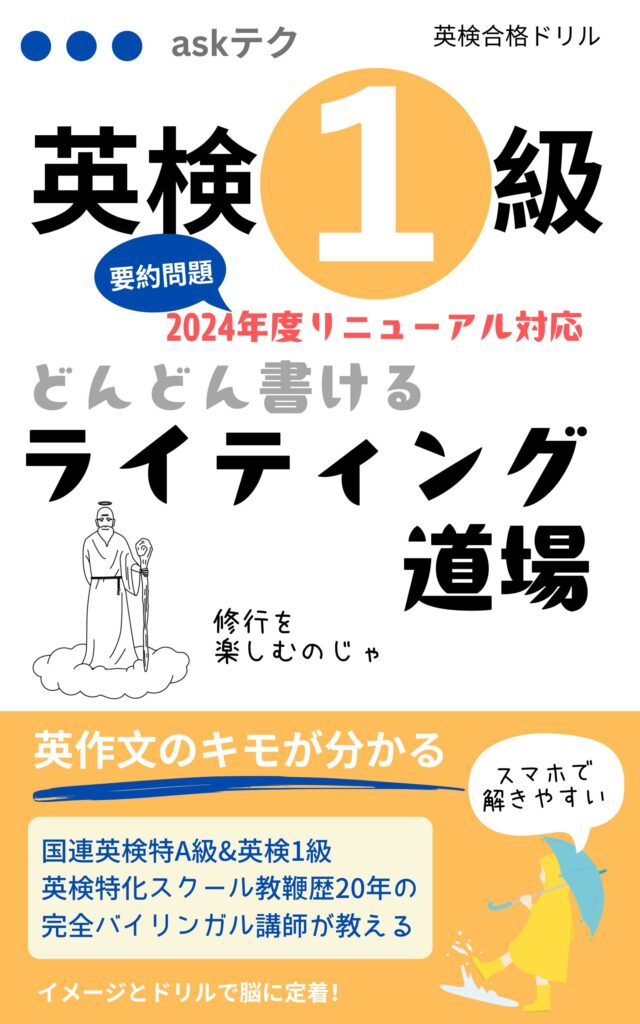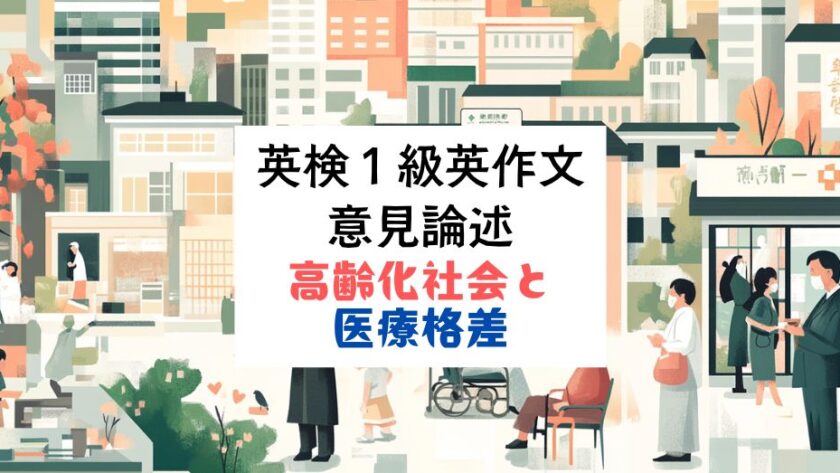(簡単★~難しい★★★★★)語彙難易度★★★★

目次
Question: Will Japan’s aging population worsen healthcare inequality?
(日本の高齢化が医療格差を悪化させるでしょうか?)
トレーニング手順
200~240語程度、3つの観点、目標解答時間:約25分
- 分野・トピック毎の観点とキーワードをまとめる
以下の画像のようなイメージ図にしておくと、記憶に定着するのでおススメ - 自分が書きやすい立場・観点で実際に書く
分からない表現はすぐに調べて15分程度で書く - 続いて、先ほどとは反対意見で書いてみる
分からない表現はすぐに調べて15分程度で書く - そのトピックについて実際に誰かと話す、又は1分スピーチをする
- 同じ分野で3つくらいの意見論述を作成する
例えば、宇宙なら宇宙植民・宇宙採掘・宇宙旅行など
6つの観点 (Perspectives)
単純化したイラストで整理することで、記憶に定着しやすくなります。

観点 (Perspectives)
- 地域間格差 (Regional Disparities)
- 都市部と地方の医療アクセスの違いが、日本の医療格差の大きな要因です。都市部では高度な医療施設や専門医が集中していますが、地方では医師不足や医療施設の減少が問題となっています。
- 経済的格差 (Economic Disparities)
- 収入や保険の違いによって、受けられる医療サービスの質や範囲が異なります。低所得者層は、必要な医療を受けられない場合があり、経済的な背景が健康格差につながっています。
- 高齢者医療の不平等 (Inequality in Elderly Care)
- 高齢者人口が増加する中で、高齢者向けの医療サービスや介護の質も地域や経済状況によって異なり、介護負担の不平等が深刻化しています。
- 技術とインフラの格差 (Technological and Infrastructure Gaps)
- 最新の医療技術やデジタルヘルスの導入が進んでいる地域と、技術的インフラが不足している地域では、医療の質に大きな差があります。
- 医療従事者の偏在 (Maldistribution of Healthcare Professionals)
- 医師や看護師の偏在により、一部の地域では医療従事者が不足し、十分な医療を提供できない状況が生じています。
キーワード (Keywords)
- healthcare disparities (医療格差)
- regional access (地域医療アクセス)
- urban-rural divide (都市と地方の格差)
- socioeconomic inequities (社会経済的格差)
- geriatric care (高齢者医療)
- healthcare infrastructure (医療インフラ)
- physician maldistribution (医師の偏在)
- public healthcare system (公的医療制度)
- digital health solutions (デジタルヘルスソリューション)
- healthcare accessibility (医療へのアクセス)
使われそうな動詞 (Verbs)
- address (対処する)
- exacerbate (悪化させる)
- mitigate (緩和する)
- allocate (配分する)
- revolutionize (革新する)
- equalize (均等化する)
- ameliorate (改善する)
- prioritize (優先する)
- reform (改革する)
- implement (実施する)
使われそうな形容詞 (Adjectives)
- equitable (公平な)
- disproportionate (不均衡な)
- insufficient (不十分な)
- underresourced (資源不足の)
- advanced (先進的な)
- localized (地域的な)
- systemic (制度的な)
- comprehensive (包括的な)
- integrated (統合された)
- preventive (予防的な)
使われそうな副詞 (Adverbs)
- disproportionately (不均衡に)
- regionally (地域的に)
- socioeconomically (社会経済的に)
- equitably (公平に)
- systematically (体系的に)
- effectively (効果的に)
- preventively (予防的に)
- continuously (継続的に)
- progressively (漸進的に)
- sustainably (持続可能に)

Yes: 高齢化で医療格差が悪化する
Japan’s aging population is likely to worsen healthcare inequality due to regional disparities, socioeconomic inequities, and the uneven distribution of healthcare professionals. These factors will make it increasingly difficult to provide equal medical care nationwide.
First, regional disparities in healthcare access are already significant, and an aging population will exacerbate this issue. Urban areas have advanced medical facilities and specialists, while rural regions face shortages of doctors and weakened healthcare infrastructure. As demand for medical services rises with aging, the gap between urban and rural healthcare will widen.
Second, socioeconomic inequities will deepen as healthcare costs increase. Many elderly individuals rely on fixed incomes or pensions, making it difficult to afford growing medical expenses. Low-income households may struggle to access necessary treatments, worsening health outcomes for disadvantaged groups. As the population ages, these financial pressures will increase, further straining access to adequate care for vulnerable populations.
Finally, the maldistribution of healthcare professionals is a critical issue. As doctors and nurses concentrate in cities, rural areas face severe shortages of medical staff. This imbalance will intensify as the elderly population in rural areas grows, leaving many without proper healthcare services.
In conclusion, Japan’s aging population will likely worsen healthcare inequality by amplifying regional, economic, and professional disparities. Addressing these challenges will be crucial to ensuring all citizens, regardless of location or income, can access the care they need. (227 words)
賛成意見の訳と用語
Japan’s aging population is likely to worsen healthcare inequality due to regional disparities, socioeconomic inequities, and the uneven distribution of healthcare professionals. These factors will make it increasingly difficult to provide equal medical care nationwide.
イントロ: 高齢化問題が医療格差を悪化させる可能性
日本の高齢化は、地域格差、社会経済的不平等、医療従事者の偏在などによって、医療格差をさらに悪化させる可能性がある。これらの要因は、全国的に平等な医療提供をますます困難にするだろう。
First, regional disparities in healthcare access are already significant, and an aging population will exacerbate this issue. Urban areas have advanced medical facilities and specialists, while rural regions face shortages of doctors and weakened healthcare infrastructure. As demand for medical services rises with aging, the gap between urban and rural healthcare will widen.
ボディ1: 地域格差の拡大
まず、医療アクセスの地域格差はすでに顕著であり、高齢化はこの問題をさらに悪化させるだろう。都市部には高度な医療施設や専門医がある一方、地方では医師不足や医療インフラの弱体化が進んでいる。高齢化に伴い医療需要が増加することで、都市部と地方の医療格差は拡大するだろう。
- “regional disparities”(地域格差)
類語: “geographical inequalities,” “area-based differences”
反語: “regional uniformity,” “equal access” - “exacerbate”(悪化させる)
類語: “worsen,” “aggravate”
反語: “improve,” “alleviate” - “shortages of doctors”(医師不足)
類語: “lack of physicians,” “deficit of doctors”
反語: “surplus of doctors,” “abundance of physicians” - “weakened infrastructure”(弱体化したインフラ)
類語: “deteriorated infrastructure,” “eroded systems”
反語: “strengthened infrastructure,” “robust systems”
Second, socioeconomic inequities will deepen as healthcare costs increase. Many elderly individuals rely on fixed incomes or pensions, making it difficult to afford growing medical expenses. Low-income households may struggle to access necessary treatments, worsening health outcomes for disadvantaged groups. As the population ages, these financial pressures will increase, further straining access to adequate care for vulnerable populations.
ボディ2: 社会経済的不平等の拡大
次に、医療費が増加するにつれて、社会経済的不平等が深刻化する。多くの高齢者は定収入や年金に頼っており、増え続ける医療費を負担するのが難しくなる。低所得世帯は必要な治療を受けることが困難になり、結果として弱者層の健康状態が悪化するだろう。人口が高齢化するにつれて、こうした財政的な圧力が増し、脆弱な人々の医療アクセスがさらに制限されることになる。
- “socioeconomic inequities”(社会経済的不平等)
類語: “economic disparities,” “income inequalities”
反語: “economic equality,” “social fairness” - “fixed incomes”(定収入)
類語: “steady income,” “pension-based income”
反語: “variable income,” “fluctuating earnings” - “vulnerable populations”(脆弱な人々)
類語: “at-risk groups,” “disadvantaged populations”
反語: “privileged populations,” “empowered groups” - “strain access to care”(医療へのアクセスに負担をかける)
類語: “limit access to healthcare,” “hinder medical access”
反語: “improve access to care,” “enhance medical access”
Finally, the maldistribution of healthcare professionals is a critical issue. As doctors and nurses concentrate in cities, rural areas face severe shortages of medical staff. This imbalance will intensify as the elderly population in rural areas grows, leaving many without proper healthcare services.
ボディ3: 医療従事者の偏在による影響
最後に、医療従事者の偏在が重要な問題となっている。医師や看護師が都市部に集中する一方、地方では深刻な医療スタッフ不足に直面している。この不均衡は、地方の高齢者人口の増加に伴いさらに激化し、多くの人が適切な医療サービスを受けられなくなるだろう。
- “maldistribution”(偏在)「不均等な分配」「偏在」を意味し、特定のリソースが不平等に分配されている状況を指す。
類語: “uneven distribution,” “imbalanced allocation”
反語: “equal distribution,” “equitable allocation” - “concentrate in cities”(都市部に集中する)
類語: “gather in urban areas,” “cluster in metropolitan regions”
反語: “spread across rural areas,” “disperse in countryside” - “severe shortages”(深刻な不足)
類語: “acute deficits,” “critical shortfall”
反語: “abundance,” “surplus” - “imbalance will intensify”(不均衡が激化する)
類語: “disparity will worsen,” “inequality will escalate”
反語: “imbalance will diminish,” “disparity will lessen”
In conclusion, Japan’s aging population will likely worsen healthcare inequality by amplifying regional, economic, and professional disparities. Addressing these challenges will be crucial to ensuring all citizens, regardless of location or income, can access the care they need.
結論:高齢化による医療格差への影響
結論として、日本の高齢化は、地域、経済、そして医療従事者の不均衡を拡大することで、医療格差をさらに悪化させる可能性がある。これらの課題に取り組むことが、すべての国民が地域や所得に関係なく必要な医療を受けられるようにするために重要である。
- “amplifying”(拡大させる)
類語: “exacerbating,” “intensifying”
反語: “diminishing,” “reducing” - “disparities”(格差)
類語: “inequalities,” “discrepancies”
反語: “equalities,” “uniformities” - “regardless of”(~に関係なく)
類語: “irrespective of,” “despite”
反語: “depending on,” “in accordance with” - “access the care”(医療を受ける)
類語: “obtain medical services,” “receive healthcare”
反語: “be denied healthcare,” “lack access to care”

No: 高齢化は必ずしも医療格差を悪化させない
Japan’s aging population will not necessarily worsen healthcare inequality, as improvements in technology, healthcare policies, and a focus on professional redistribution can help mitigate disparities.
First, advancements in medical technology, such as telemedicine, can reduce regional disparities in healthcare access. Telemedicine allows patients in rural areas to consult with specialists in urban centers without traveling. This technology can bridge the gap between urban and rural healthcare, providing elderly patients with access to quality care, regardless of location.
Second, government policies aimed at reducing healthcare costs can help address socioeconomic inequities. Japan’s universal healthcare system already provides affordable access to medical services, and further reforms could focus on reducing out-of-pocket expenses for the elderly. Subsidies or expanded insurance coverage for low-income households can ensure that all elderly individuals, regardless of their financial situation, receive the care they need.
Finally, efforts to redistribute healthcare professionals can help balance the concentration of doctors and nurses between urban and rural areas. Incentive programs, such as higher salaries or student loan forgiveness for healthcare workers in rural regions, can encourage more professionals to serve in areas with shortages. This would help ensure that rural elderly populations have access to skilled medical care.
In conclusion, while Japan’s aging population poses challenges, advances in technology, government intervention, and professional redistribution efforts can prevent healthcare inequality from worsening. These solutions can ensure equitable access to healthcare for all citizens. (233 words)
反対意見の訳と用語
Japan’s aging population will not necessarily worsen healthcare inequality, as improvements in technology, healthcare policies, and a focus on professional redistribution can help mitigate disparities.
イントロ:高齢化は必ずしも医療格差を悪化させない
日本の高齢化は、必ずしも医療格差を悪化させるわけではない。技術の進歩、医療政策の改善、医療従事者の再配置に焦点を当てることで、格差を緩和できる。
First, advancements in medical technology, such as telemedicine, can reduce regional disparities in healthcare access. Telemedicine allows patients in rural areas to consult with specialists in urban centers without traveling. This technology can bridge the gap between urban and rural healthcare, providing elderly patients with access to quality care, regardless of location.
ボディ1:テクノロジーの進歩が地域格差を緩和する
まず、遠隔医療のような医療技術の進歩が、地域の医療アクセス格差を緩和することができる。遠隔医療により、地方に住む患者は都市部の専門医に移動せずに相談できる。この技術は、都市部と地方の医療格差を埋め、高齢者が居住地に関係なく質の高い医療を受けられるようにする。
- “advancements in medical technology”(医療技術の進歩)
類語: “innovations in healthcare technology,” “medical breakthroughs”
反語: “technological stagnation,” “lack of innovation” - “telemedicine”(遠隔医療)
類語: “remote healthcare,” “virtual consultations”
反語: “in-person consultations,” “traditional healthcare” - “bridge the gap”(格差を埋める)
類語: “close the gap,” “reduce disparities”
反語: “widen the gap,” “exacerbate the difference” - “regardless of location”(場所に関係なく)
類語: “irrespective of location,” “no matter the place”
反語: “depending on location,” “based on region”
Second, government policies aimed at reducing healthcare costs can help address socioeconomic inequities. Japan’s universal healthcare system already provides affordable access to medical services, and further reforms could focus on reducing out-of-pocket expenses for the elderly. Subsidies or expanded insurance coverage for low-income households can ensure that all elderly individuals, regardless of their financial situation, receive the care they need.
ボディ2:政府の医療費削減政策
次に、医療費削減を目指す政府の政策が、社会経済的不平等を解消する手助けとなる。日本の国民皆保険制度はすでに医療サービスへの手頃なアクセスを提供しているが、さらなる改革により、高齢者の自己負担額の削減に焦点を当てることができる。低所得世帯向けの補助金や保険適用範囲の拡大は、すべての高齢者が経済状況に関係なく必要な医療を受けられることを確保できる。
- “government policies”(政府の政策)
類語: “public policies,” “state initiatives”
反語: “lack of regulation,” “policy void” - “universal healthcare system”(国民皆保険制度)
類語: “national health coverage,” “comprehensive healthcare system”
反語: “private healthcare system,” “limited healthcare access” - “out-of-pocket expenses”(自己負担額)
類語: “personal medical costs,” “direct healthcare expenses”
反語: “fully covered expenses,” “insurance-covered costs” - “expanded insurance coverage”(保険適用範囲の拡大)
類語: “broadened insurance coverage,” “enhanced medical coverage”
反語: “limited coverage,” “restricted insurance benefits”
Finally, efforts to redistribute healthcare professionals can help balance the concentration of doctors and nurses between urban and rural areas. Incentive programs, such as higher salaries or student loan forgiveness for healthcare workers in rural regions, can encourage more professionals to serve in areas with shortages. This would help ensure that rural elderly populations have access to skilled medical care.
ボディ3:医療従事者の再配置
最後に、医療従事者の再配置の取り組みが、都市部と地方の医師や看護師の偏在を解消する助けとなる。地方で働く医療従事者に対する高額給与や学生ローンの返済免除といった奨励プログラムが、より多くの専門家を人手不足地域に送り込むことを促進するだろう。これにより、地方の高齢者人口が熟練した医療サービスを受けられるようになる。
- “redistribute healthcare professionals”(医療従事者を再配置する)
類語: “reallocate medical staff,” “reassign healthcare workers”
反語: “concentrate professionals,” “centralize healthcare workers” - “incentive programs”(奨励プログラム)
類語: “reward schemes,” “motivational programs”
反語: “disincentive programs,” “penalizing schemes” - “student loan forgiveness”(学生ローンの返済免除)
類語: “debt cancellation,” “loan relief”
反語: “loan repayment,” “student debt accumulation” - “areas with shortages”(不足している地域)
類語: “underserved regions,” “areas with deficits”
反語: “areas with surpluses,” “well-staffed regions”
In conclusion, while Japan’s aging population poses challenges, advances in technology, government intervention, and professional redistribution efforts can prevent healthcare inequality from worsening. These solutions can ensure equitable access to healthcare for all citizens.
結論:技術・政策・再配置で医療格差を防ぐ
結論として、日本の高齢化は課題を提起するものの、技術の進歩、政府の介入、医療従事者の再配置の取り組みが、医療格差の悪化を防ぐことができる。これらの解決策により、すべての市民が平等に医療へアクセスできるようになるだろう。
- “advances in technology”(技術の進歩)
類語: “progress in technology,” “technological developments”
反語: “technological regression,” “lack of innovation” - “government intervention”(政府の介入)
類語: “government involvement,” “state action”
反語: “government withdrawal,” “lack of intervention” - “prevent…from worsening”(悪化を防ぐ)
類語: “stop…from deteriorating,” “keep…from getting worse”
反語: “allow to worsen,” “enable to deteriorate” - “equitable access”(公平なアクセス)
類語: “fair access,” “equal access”
反語: “unequal access,” “discriminatory access”
まとめ
学習の振り返りコラム:高齢化による医療格差に関する賛成・反対意見論述
今回の学習では、「日本の高齢化が医療格差を悪化させるかどうか」というテーマに対して、賛成・反対の立場からエッセイを作成しました。このエクササイズを通じて、論理的に説得力のあるエッセイを作成するためのコツや、汎用的な語彙やフレーズの使い方について学びました。
論理的なエッセイを書くコツ
英検1級の意見論述では、まず立場を明確にすることが重要です。その後、主張を支持する理由を論理的に展開し、具体的な事例やデータを用いて裏付けることが効果的です。今回の賛成・反対のエッセイでは、それぞれの立場に応じて「地域格差」「社会経済的不平等」「医療従事者の偏在」などの具体的な観点を取り上げ、根拠を明確にしました。
賛成側では、地域格差や医療従事者の偏在が高齢化によって拡大するという懸念を挙げ、反対側ではテクノロジーの進化や政策の改善によってその課題が解決可能であることを強調しました。こうした論理展開において、各段落が明確な役割を持ち、全体の流れが途切れないように構成することが大切です。
汎用的に使える語彙やフレーズ
今回のエッセイでは、様々なトピックに応用可能な汎用的な語彙やフレーズを学びました。例えば:
- “regional disparities”(地域格差)
- “socioeconomic inequities”(社会経済的不平等)
- “mitigate disparities”(格差を緩和する)
- “government intervention”(政府の介入)
- “equitable access to healthcare”(公平な医療アクセス)
これらの表現は、他のトピックでも役立つ汎用性の高いフレーズです。また、「AがBを悪化させる」という表現や、逆に「AがBを改善する」という形で賛成・反対の立場を鮮明にするためのフレーズを学びました。例えば、「exacerbate」や「mitigate」のような単語を使うことで、より洗練された表現が可能になります。
論理展開と説得力を高める方法
また、各段落で一つの主張を明確にし、根拠とともに論理的に展開することが、エッセイ全体の説得力を高める上で重要であることを再確認しました。結論段落では、すべての議論を要約し、立場を強く主張することで、エッセイを締めくくることが効果的です。
この学習を通じて、論理的な流れを保ちながら明確な主張を展開するスキルや、様々なトピックに対応できる表現を身に付けることができました。今後も、こうした技術を応用し、より高得点を目指していきましょう。
英検1級英作文(意見論述・要約問題)・二次試験(面接)リストはコチラ
英検1級トピック探しにおススメのサイト:Britanica ProCon.org
英作文(意見論述・要約問題)対策テキスト

「どんなテキストがおすすめですか?」とよく聞かれるのですが、「問題量が多い」ものと「知識量を増やせるもの」の2種類を準備すると良いかと思います。
また、あまりにも文法解説が長いテキストは、英検1級対策としては、「?」という感じがします。
「何を、どんな観点で、どう伝えるか」にフォーカスして書かれたテキストを選んでください。
英作文テキストは、「最低でも3ラウンドする」。語彙や表現を増やす系のテキストは「最低でも5ラウンドする」つもりで、1ページごとに時間をかけすぎず、分からない時はすぐにググりながらテンポよく進めていきます。




